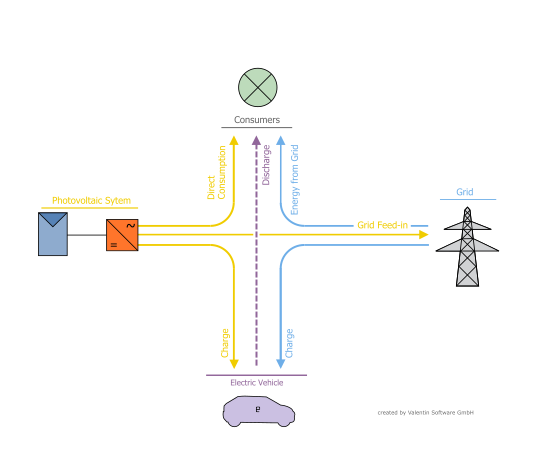Electric vehicles
Electric vehicles are calculated by PV*SOL® like battery systems. The battery inverter is then the charging station of the vehicle.
The modeling of electric vehicles then differs mainly in the absences of the “battery” (i.e. the vehicle) and the energy management during charging.
Energy Management
If a battery system is available in addition to the electric vehicle, this can be used in both charging modes to charge the electric vehicle. The battery system takes precedence over the mains.
- The load is always covered first
- In Charging mode " Default" the electric vehicle behaves like an additional load as soon as it is connected to the charging station (as soon as it returns after a journey)
- The load (normal loads and/or electric vehicle in standard charging mode) is covered by PV, battery and mains with the following priority
- PV
- Battery storage
- Grid
- If energy is still available after covering consumption and charging the vehicle, the battery system will be charged if it is not fully charged.
- If the batteries are full or cannot absorb everything due to the connected load, the rest is fed into the mains.
- In Charging mode “PV optimized”, the electric vehicle does not immediately behave like an additional load. The minimum load quantity that the vehicle needs for the next trip is determined. From this (and from the connected load of the charging station) the time is determined when charging from the mains (or, if available, the battery store) must begin at the latest. Until then, the car will be charged by the PV if sufficient PV energy is available (i.e. if the load is already covered). In this way, the proportion of PV energy can be significantly increased depending on the time the vehicle is available at the charging station.
- Only when charging from the mains/battery is no longer avoidable in the “PV optimised” charging mode is the necessary charging power requested from the vehicle. The battery system tries to take over as much of this as the connected load and state of charge allow. The rest is covered from the net.
- If more PV energy is available than would at least be necessary for the next trip, the vehicle is still preferably charged.
- All these processes are of course significantly influenced by the time availability of the vehicle at the charging station, the connected load of the charging station, the connected load of the battery system and the PV load.
See also
